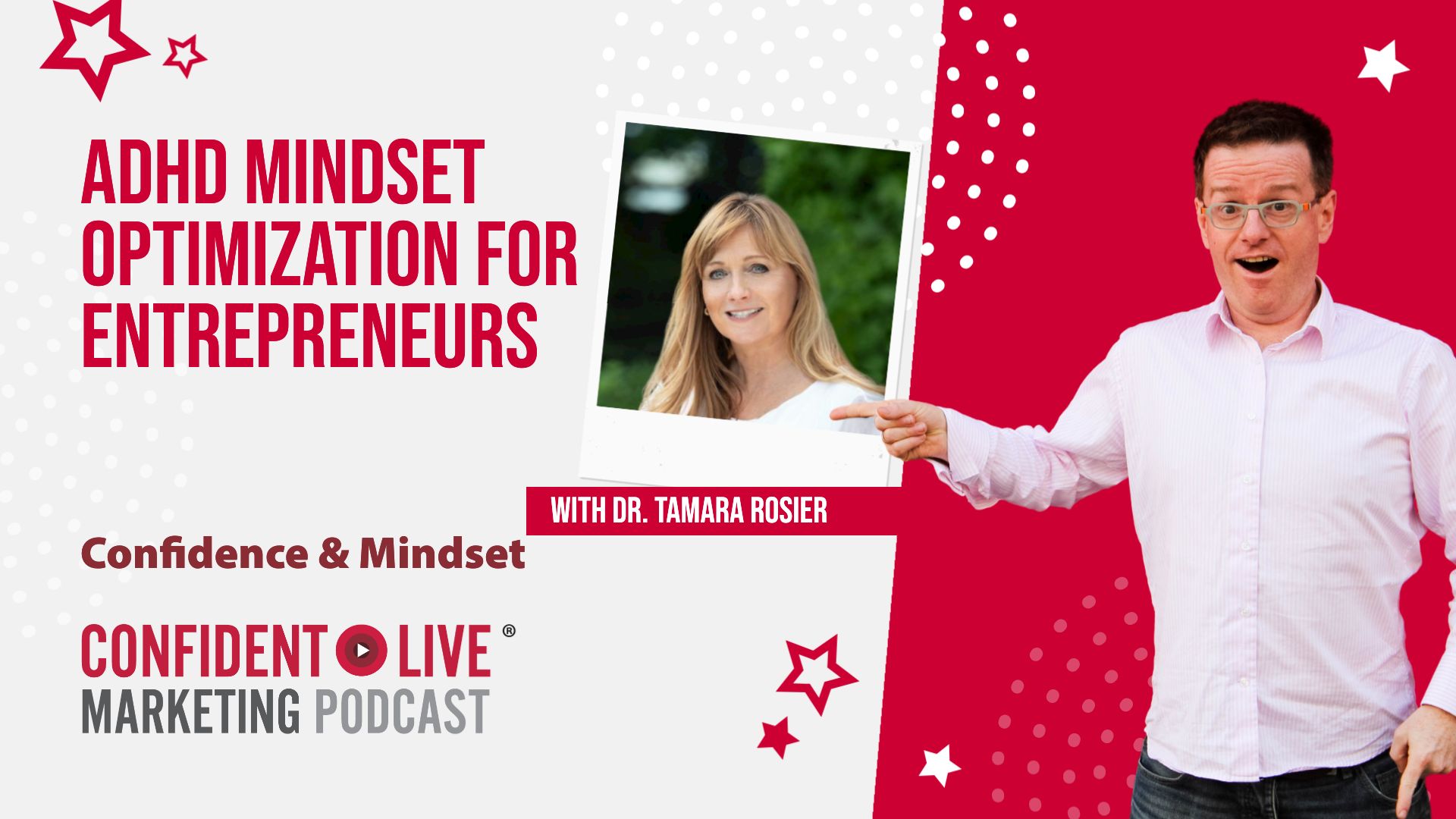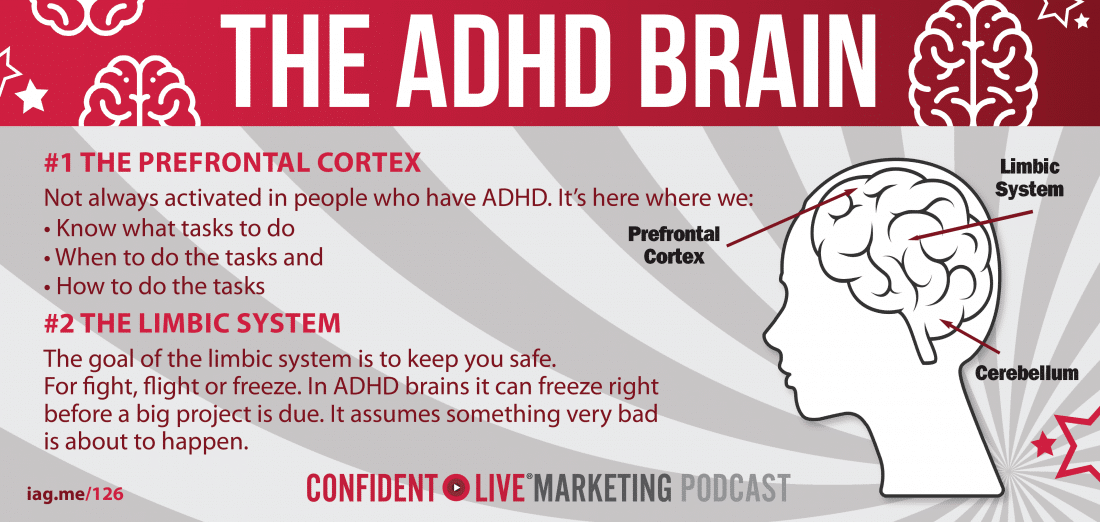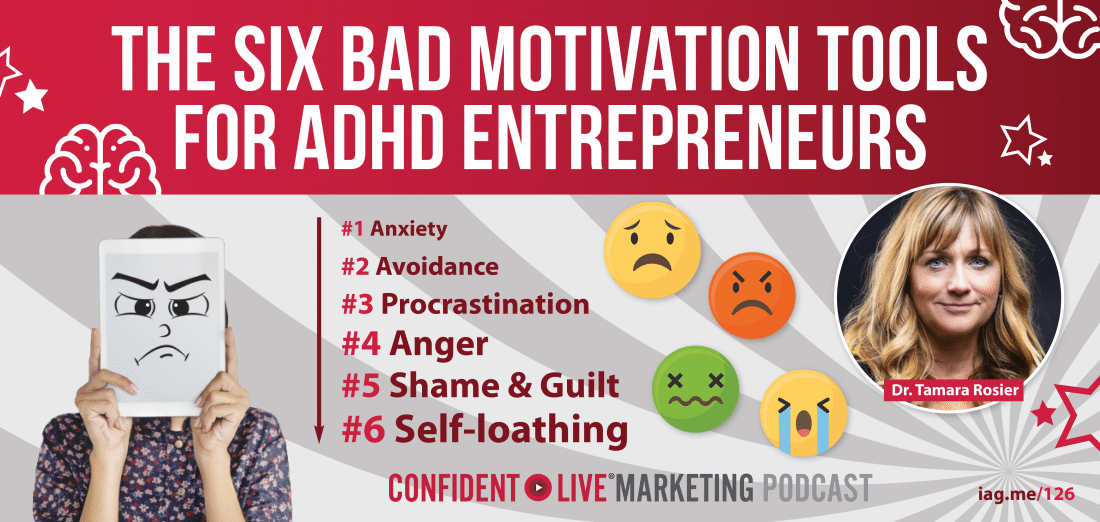ADHD Mindset Optimisation for Entrepreneurs
Confident Live Marketing Podcast
Episode 126
Duration: 1 hour 26 minutes
Episode Theme: Confidence & Mindset
September 17, 2021

Do you get distracted easily?
Do you procrastinate when you have to do really boring tasks?
Have you looked into whether you have ADHD?
Read on for advice on how entrepreneurs can effectively manage their ADHD and have success in business and life.
This article is based on my interview with Dr. Tamara Rosier, who shared her top ADHD mindset optimisation tips for entrepreneurs. Dr. Rosier has been a college administrator, a professor, a leadership consultant, a high school teacher, a national public speaker and an ADHD coach through these adventures.
As founder of the ADHD Centre of West Michigan, she leads a team of coaches, therapists and speech pathologists to help individuals, parents and families develop an understanding and learn skills to live with ADHD effectively.
Her book, Your Brain is not Broken, provides strategies for navigating the powerful emotions accompanied with ADHD.
What You’ll Learn
How Tamara became interested in ADHD
What is ADHD?
Having ADHD symptoms but not ADHD
Why those with ADHD do lots of different things
Types of ADHD
When to get a professional diagnosis
“Six bad tools” for motivation
Where medication fits in
Sugar and ADHD
How Tamara’s ADHD coaching works
How to deal with overwhelm
Perfectionism and overthinking
Tamara’s final tips
Tamara’s Interest in ADHD
Entrepreneurs tend to be 300% more likely to have ADHD than neurotypicals, says Tamara, and yet most of them will regard it as a dirty little secret they’re not comfortable with.
In her book, she ‘comes out’ as an ADHD person and what that’s like for her, and she encourages others to talk about it too.
Tamara says it’s pretty obvious from her bio that she has ADHD. Most people with ADHD get bored easily and change jobs a lot. She started her career as a high school teacher, working with high-risk kids.
At that time – the early 90s – ADHD was known about but not often talked about, but Tamara found a niche in being able to talk to young people with it. She’s found that ADHD people often get in tune with each other because they speak the same language.
After a few years, she was ready to move on; a colleague suggested she be an ADHD coach. She’d never heard of it before, but took the advice and changed careers.
What is ADHD?
There are two parts of the brain that are affected by ADHD.

#1 The Prefrontal Cortex
This is at the front of your brain and is not always activated in people who have ADHD.
It’s here where we:
- Know what tasks to do
- When to do the tasks and
- How to do the tasks.
“I might know what I need to do, I just don’t really know how or when to start it. And a lot of entrepreneurs have that problem.”
#2 The Limbic System
The second part of the brain is in the limbic system, and it looks like the “brain within the brain” when you see it on the computer.
The only goal of the limbic system is to keep you safe, but when you have ADHD it’s very “twitchy”. It goes off where it shouldn’t go off, and it doesn’t go off when it should.
The limbic system is for fight, flight or freeze. However, Tamara says she often works with individuals who go and freeze right before a big project is due – what happens is your brain accidentally assumes something bad is happening to you and your brain freezes.
ADHD people often misjudge what’s a real threat and what’s a minor inconvenience. And because of that, they respond emotionally. They also have a different way of approaching things, and sometimes feel disinclined to start something new.
Many people assume it’s a moral deficiency or they’re lazy, instead of realising that they have an executive function problem and their brain doesn’t know what to do, how or when to do it.
ADHD Symptoms but not ADHD…
There are a lot of things that mimic ADHD. For example OCD, PTSD and anxiety can all affect the prefrontal cortex and limbic system at the same time. To establish if this is really the case, you’d need to see a psychologist.
However, if you don’t have ADHD but have ADHD-like symptoms, your prefrontal cortex is still under attack and it still doesn’t know what to do. So the advice for those with symptoms is the same as for those who actually have it.
It’s also important to note that there’s a hereditary component. Tamara finds that the parents of the children she works with don’t know where it’s come from until she describes the behaviours and they recognise them in themselves.
Doing Lots of Different Things
Tamara says our nervous system is motivated by new and exciting things. We’re like hunters in a farming world. And a modern hunter is an entrepreneur – they get a thrill from trying new things. Some even get a thrill from failing.
The Danger of Hyperfocus
Being an entrepreneur can be new, scary, and exciting, and the ADHD brain gets a hit from that and we love it. Sometimes people with ADHD get hyper-focused and get very involved in a task; they can’t move on until it’s done.
Tamara says this is dangerous because they might be hyper-focusing on the wrong thing. She teaches her clients to go into a flow state rather than a hyper-focus state. This requires a big shift in how they think.
Divergent vs Convergent Thinking
For people with ADHD, we’re good at divergent thinking. That’s thinking up new ideas, putting ideas together, creativity and more. But we’re not so good at finishing things off. That requires convergent thinking and paying attention to details.
Types of ADHD
Tamara says that the diagnostic style manual is probably a good 20 years behind the research on ADHD and is actually missing a lot of cases, especially high IQ women with ADHD. They can fake it and they can look very professional, just slightly anxious.
This means that the current diagnostic is sorely lacking. Our understanding and research of ADHD is blowing up because now we can actually see the brain and have great FMRI and other brain imaging studies. This has increased understanding massively.
The Diagnostic and Statistical Manual of Mental Disorders uses inattentive, attentive and combination types of ADHD, and that’s not entirely helpful either. You could say there are as many types of ADHD as there are people with ADHD. You could be hyperactive in a physical way, or in your head- for example, your brain feels like it’s got a cacophony of sounds. It’s like having 50 ideas in your head and they’re all competing for time.
When to get a Professional Diagnosis
If people think that they might have ADHD, they often feel that they need a professional diagnosis. Tamara says that making the decision depends on how much your symptoms are hurting you.
“If you wake up in the morning and feel that you can’t deal with the day because you’re overwhelmed before you get up, or you’re scared of all the things you have to do, a diagnosis will be helpful.”
But if you’re able to get through life aware of your strengths and weaknesses and can accommodate them to manage any challenges, then you don’t need to get a diagnosis.
Six “Bad Tools” for Motivation
Tamara explains that she has identified six “bad tools” that people with ADHD use to motivate themselves. If they’re being used every day, people will eventually feel worn down and that can result in depression and more. The tools become more and more extreme as we find that the tools we used before aren’t as effective.
#1 Anxiety
Using anxiety is like trying to set your limbic system on fire to motivate yourself. If someone is using anxiety to motivate themselves, they need to see a doctor and probably take medication.
#2 Avoidance
Avoiding something is often a genius trick. Tamara gives the example of a student who had an important test coming up – instead of studying for it, she rearranged her sock drawer.
#3 Procrastination
We learn this trick very young – and it’s a combination of anxiety and avoidance. It’s when you leave it to the last minute, and the pressure of the deadline kickstarts your brain into doing the task.
#4 Anger
For example, someone who was so angry that his wife asked him to clean the garage that he did it out of spite. Unfortunately, this backfired because then his garage was clean and his wife was happy. And in order to do a chore, he had to work up his anger and exhaust himself in the process.
#5 Shame & Guilt
This is a darker trick, when we sink down we tend to shame ourselves about the fact that we can’t do our tasks. It’s a sad and sorrowful emotion that we use to make us do the tasks we don’t want to do. Shame comes from comparing yourself with others. The older people get without being diagnosed with ADHD, the more likely they are to use shame to motivate themselves.
#6 Self-loathing.
Self-loathing is the darkest tool we can use. You beat yourself up in order to do the task.

Where Medication Fits In
In the 1980s, treatment involved using basic stimulants, leading to over-medicated kids being given inadequate medication. Things have vastly improved in recent years.
Medication is kind of similar to the way wearing glasses helps people who are nearsighted see. Glasses don’t teach you how to read, but they give your eyes the appropriate lens so that you can see more clearly. Medication helps people with ADHD have calmer and more focussed brains.
80% of people respond well to a stimulant and it doesn’t give them side effects. There are other types of drugs used in ADHD treatment, but stimulants are usually used first.
Recent research has found that those who are undiagnosed and unmedicated with ADHD (which causes them emotional challenges) live 13 years less. For instance, young men with ADHD often make impulsive decisions when driving, or people neglect to look after their health.
Tamara encourages her clients to do two things every day:
- Brush their teeth
- Go to bed early.
Many people with ADHD dislike doing both of these, but they can have a negative impact on the quality of their lives.
Sugar and ADHD
Research into the impacts of sugar on people with ADHD is very new. However, it is known that ADHD brains are prone to addiction and sugar is highly addictive. Furthermore, ADHD brains don’t detoxify as quickly and as well.
Sugar is an inflammatory agent, and for the ADHD brain it feels like dopamine, leading to quick highs followed by huge crashes. Similarly, coffee, tea and soft drinks are also stimulants, and many untreated people will use these regularly.
Tamara says that there are better ways to manage ADHD which can also be easier on the stomach. There are a lot of neurons in the stomach and we need the liver to break down stimulants rather than the stomach.
ADHD Coaching
Tamara explains that she works with exceptionally bright people who are creative and imaginative and encourages them to work on the ‘grown-up’ parts of life. They look at different ways of thinking – what to do, how and when to do it.
In her coaching, Tamara helps with emotional regulation, which calms down the limbic system and helps it to identify real risks from hypothetical risks. She also offers cognitive flexibility, which helps the brain see there are different options available.
Finally, there’s cognitive control, which is when the brain is able to make a choice. People begin to understand their thinking patterns and how these patterns will make them feel.
How to Deal with Overwhelm
It’s essential for people to understand the difference between divergent thinking and convergent thinking, Tamara says.
Divergent thinking is the wild creative – thinking in a constellation where everything’s related.
Convergent thinking is the boring, grown-up and less creative part. For instance, you might enjoy making videos for YouTube but don’t like the editing part. It’s important to know what to do when you get stuck at the convergent part.
Any time you have to initiate a task, ask yourself, “Is this a convergent task? If it is, then I have no emotional interest. And if I have no emotional interest, what can I do to find it?”
You may decide to focus on one task at a time to get it done; it can be helpful to change your environment. For instance, you might go to a coffee shop and sit there until it’s done.
You might also decide to optimise your time by finding outside help. Hire someone who can take over the convergent tasks that you dislike and put off doing, and focus your time on the divergent work you enjoy.
Perfectionism and Overthinking
Perfectionism is also a trait of people with ADHD. People feel that if they can’t do something perfectly, they’ll keep working until they get there. They’re idealistic about what perfection is without really knowing what it means. They’ll keep searching for it.
People with a neurotypical brain, however, will say, “That’s good enough for right now. I’ve brought it to a finished product.” They know when something is done, but an ADHD person doesn’t.
Overthinking things and striving for perfection can lead to hyper-focus in order to complete a task you’re not keen on, but it also leads to procrastination and avoidance.
Tamara had some advice for how to just get things done:
“You’re not finding a task fun or emotionally interesting, so you have to change one of those two variables; either turn up the emotional energy or make it fun somehow.”
Medication can turn on the “just do it” button, and people find it easier just to get started on a task.
She adds that ADHD people don’t know how to sequence their activities, which can make it harder for them to get started. With her clients, Tamara encourages people to write down each step they need to do to get a task completed.
As you work through the process, what you think is the first step is actually further down the list. The more you think about it, the more likely you are to be able to identify that first step.
The ADHD brain doesn’t know where to start, so a list can make a big difference. You really can’t order a list of steps as much as you think you can. Write down every step, no matter how small, and check them off.
Tamara’s Final Tips
For people with ADHD, making lists can make them anxious, so Tamara is very clear that what’s required is a step-by-step list mapping the task from beginning to end, not a to-do list.
You can pre-order Tamara’s book, ‘Your Brain’s not Broken’ on Amazon, or visit www.iag.me/brain and be redirected to the appropriate page. She says she was inspired to write a book after listening to her clients talking about how much pain they were in.
She says the book is like a letter to the clients she doesn’t have yet. It tells them what she wants them to know about their brain and what they can do about it. You don’t have to suffer or feel shame.
You can find an ADHD coach like Tamara on adhdeurope.eu. Tamara herself is the president of ACO, the ADHD coaching organisation: www.adhdcoaches.org. Also, check out the website for Tamara Rosier.
Resources
- Your Brain’s Not Broken
- ADHD Europe
- ACO (ADHD Coaching Organization)
- Tamara’s Website


